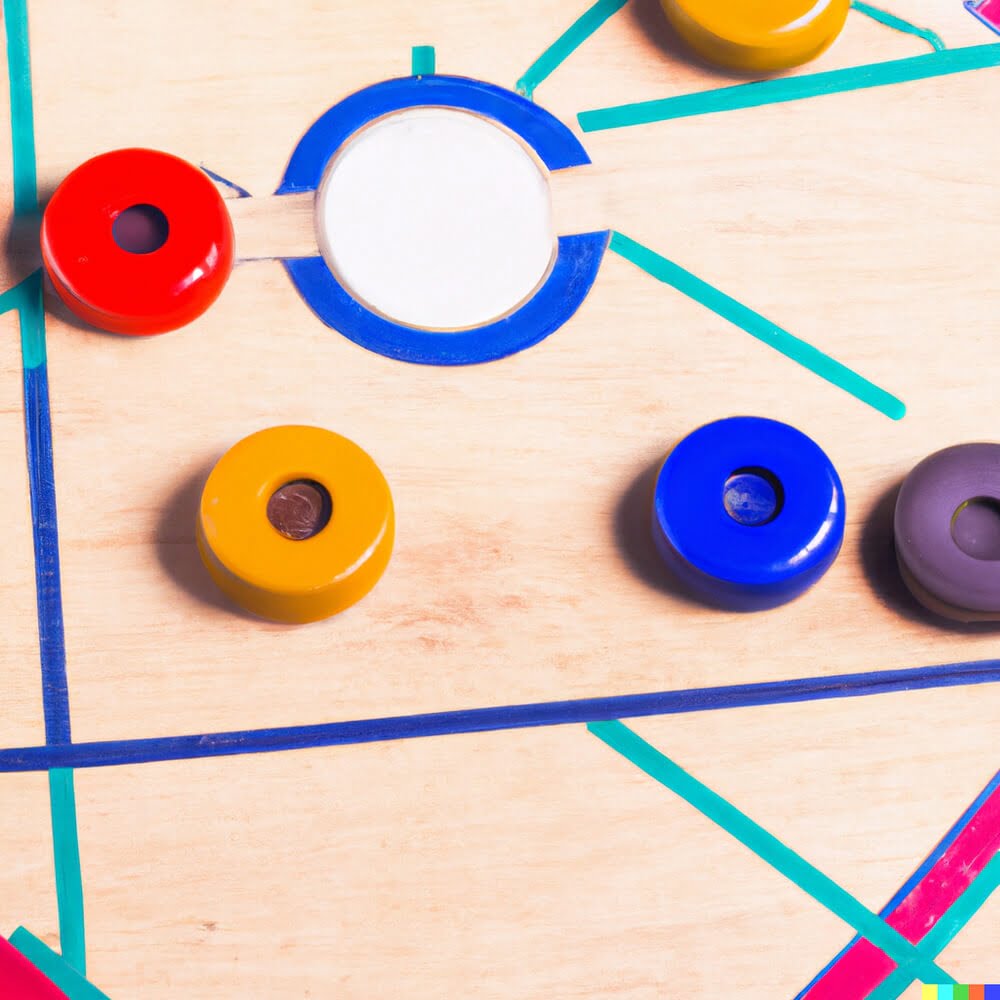Classic Indian board games have a rich and fascinating history that dates back centuries. These traditional games are not only a source of entertainment but also hold cultural and historical significance. In this article, we will delve into the world of classic Indian board games, exploring their origins, evolution, gameplay, and their influence on Indian society and culture.
The history of classic Indian board games is a testament to the enduring appeal of these ancient pastimes. From the early beginnings to their modern-day revival in the digital age, these games have stood the test of time, captivating generations with their unique gameplay and strategies. Whether it’s Pachisi, Chaupar or other traditional board games, each game offers a glimpse into India’s vibrant heritage and traditions.
Indian mythology and folklore have played a significant role in shaping classic Indian board games. Many of these games are inspired by ancient tales, characters, and symbols from Hindu mythology. The influence of these narratives adds an extra layer of depth and meaning to the gameplay, making them an integral part of India’s cultural tapestry. Join us as we embark on a journey to uncover the hidden stories behind these timeless classics.
The History of Classic Indian Board Games
Ancient Origins
Classic Indian board games have a history that dates back thousands of years, with evidence of their existence found in archaeological excavations and historical texts. Games like Pachisi, also known as Twenty-Five, are believed to have originated in ancient India and were played by royalty and commoners alike. The design and rules of these ancient games provide insights into the societal structure and values of the time.
Evolution Over Time
Over the centuries, classic Indian board games have undergone significant changes, adapting to the cultural, technological, and societal developments of each era. From being played on handmade boards with natural materials to incorporating intricate designs and craftsmanship, these games have evolved while retaining their essence. With influences from different regions and foreign invasions, the gameplay, strategies, and symbolism of classic Indian board games have continued to evolve.
Preservation and Revival
Despite facing challenges from modern forms of entertainment, classic Indian board games have managed to survive through dedicated efforts to preserve their legacy. Organizations and enthusiasts have worked towards promoting these traditional games by organizing tournaments, creating digital versions, and conducting workshops. The revival of classic Indian board games showcases the enduring appeal they hold for people seeking a connection to their cultural roots.
As we delve into the history of classic Indian board games, it becomes evident that these timeless pastimes continue to captivate people with their blend of tradition, strategy, and social interaction. The ancient origins and evolution of these games provide a window into India’s rich cultural heritage while offering an enjoyable way for people to connect across generations.
Traditional Indian Board Games
When it comes to classic Indian board games, two ancient games that have stood the test of time are Pachisi and Chaupar. These traditional board games have been played in India for centuries and continue to be enjoyed by people of all ages.
Pachisi, also known as Twenty-Five, is believed to have originated in ancient India and is often referred to as the “royal game of India.” Similarly, Chaupar has a rich history dating back to the epic Mahabharata and has been a popular pastime for generations.
Pachisi involves the use of cowrie shells as dice and players maneuver their pieces around the board based on the outcome of the dice roll. The game is steeped in strategy and requires calculated moves to navigate through the board while also hindering opponents’ progress.
On the other hand, Chaupar features a cross-shaped board with pawns or tokens that are moved based on throws of six or seven cowrie shells. Both games offer a glimpse into traditional Indian gameplay and provide an engaging experience that combines luck and skill.
These classic Indian board games are not only sources of entertainment but also hold cultural significance. They serve as a means for preserving traditions and passing down cultural heritage from one generation to another.
Additionally, they showcase the artistry of traditional game design, often featuring intricate boards adorned with vibrant colors and unique patterns that reflect Indian aesthetics. As more people recognize the value of preserving these timeless games, efforts are being made to reintroduce them into modern-day society, keeping their legacy alive for future generations.
| Classic Indian Board Game | Description |
|---|---|
| Pachisi | An ancient game involving cowrie shells as dice where players strategically maneuver their pieces around the board |
| Chaupar | A game with a cross-shaped board where pawns are moved based on throws of cowrie shells, offering an engaging mix of luck and strategy |
The Influence of Indian Mythology and Folklore on Classic Indian Board Games
Classic Indian board games have a deep-rooted connection to the rich mythology and folklore of the country. Many traditional games are intricately intertwined with stories and characters from Hindu epics such as the Ramayana and Mahabharata, as well as ancient folk tales passed down through generations. This influence adds a layer of cultural significance and nostalgia to the gameplay, making these games more than just recreational activities.
One prime example of this influence is the game of Snakes and Ladders, known in India as Moksha Patam. The game is said to be a reflection of the concept of karma from Hindu philosophy, where ladders represent virtues that lead to heaven, while snakes symbolize vices that lead to rebirth in lower forms of life. By incorporating such philosophical elements into the game, players are not only engaged in friendly competition but also subconsciously imbibe moral values.
Furthermore, another classic Indian board game deeply steeped in mythology is Pachisi, believed to have been derived from an ancient Indian game called Chaupar. Pachisi is famously associated with the epic Mahabharata, with each piece on the board representing characters from the story. The gameplay reflects the strategic maneuvers and alliances seen in the mythological tale, adding a layer of storytelling and historical relevance to the gaming experience.
To further illustrate these connections between classic Indian board games and mythology:
- Many games feature boards or pieces adorned with symbols or motifs from Hindu deities or ancient scriptures.
- Stories related to these games are often shared during gameplay sessions, keeping alive traditional narratives.
- The rules and objectives of certain games mirror themes found in Indian religious texts and folklore.
Overall, it is clear that classic Indian board games are not just sources of entertainment but also serve as vehicles for preserving and celebrating India’s vibrant mythological heritage. These games offer a unique way for people to engage with age-old stories and teachings while enjoying timeless gameplay.
Regional Variations
Introduction
Classic Indian board games have a rich and diverse history, with each region of the country contributing to the unique tapestry of traditional games. These games not only reflect the cultural and social fabric of India but also serve as a timeless source of entertainment for people of all ages.
In this section, we will delve into the regional variations of classic Indian board games, shedding light on the distinct characteristics and gameplay that make each game a treasured part of Indian culture.
North India: Pachisi and Chaupar
In North India, Pachisi and Chaupar are two classic board games that have stood the test of time. Pachisi, believed to have originated in ancient India, is widely regarded as the ancestor of modern-day Ludo. The game is played on a cross-shaped board with 68 squares and requires strategic thinking and tactical moves to navigate one’s pieces around the board.
Similarly, Chaupar is another popular game in the region, characterized by its cloth-based board and four wooden pawns for each player. Both games have deep roots in Indian mythology and are often associated with tales from epics like the Mahabharata.
South India: Pallanguli and Ashta Chamma
Moving towards South India, we encounter Pallanguli and Ashta Chamma, two traditional board games that hold significance in this region. Pallanguli involves a unique board with 14 cups carved into it, where players must sow seeds strategically while following specific rules to capture their opponent’s seeds.
Ashta Chamma, on the other hand, is a game that requires both skillful play and mathematical calculations as players maneuver their pieces across a gridded board. These games not only showcase the different gameplay styles prevalent in South India but also highlight the importance of logical thinking and arithmetic skills.
This exploration highlights just some examples of how classic Indian board games vary across different regions within the country. Each game carries with it deep cultural significance and provides insight into the values and traditions cherished by people throughout history. It is through these regional variations that we truly appreciate the diversity and richness of classic Indian board games.
Modern-Day Revival
The digital age has brought about a resurgence of interest in classic Indian board games, as people seek to reconnect with traditional forms of entertainment. The allure of these timeless games lies in their ability to provide both recreation and intellectual challenge. As modern technology continues to transform the way we interact and engage with the world around us, the revival of classic Indian board games is a testament to their enduring appeal.
One of the factors contributing to the resurgence of classic Indian board games is the growing nostalgia for simpler times. In an era dominated by digital screens and virtual experiences, there is a yearning for more tangible and authentic forms of recreation. Classic Indian board games offer a refreshing alternative, allowing players to engage in face-to-face interactions and enjoy the tactile experience of moving game pieces on a physical board.
Furthermore, the advent of online platforms and mobile applications has made it easier than ever for enthusiasts to access and play classic Indian board games. These digital adaptations not only introduce these traditional games to a new generation but also provide an opportunity for seasoned players to continue enjoying them in a convenient format.
Whether it’s playing Pachisi or Chaupar against AI opponents or competing with friends in online multiplayer modes, digital platforms are helping to popularize classic Indian board games across various demographics.
- Embracing Traditional Forms of Entertainment
- Accessibility Through Digital Platforms
- Appealing to Diverse Audiences
Strategy and Skills
Classic Indian board games are not only a source of entertainment but also a reflection of the rich cultural heritage and strategic thinking of the Indian subcontinent. These classic games have been played for centuries, with each game having its own unique set of rules and gameplay. Understanding the gameplay and tactics of classic Indian board games allows players to appreciate the intricate strategies involved and the skill required to emerge victorious.
One of the most popular classic Indian board games is Pachisi, which is believed to have originated in ancient India. The game involves moving pieces around a cross-shaped board, and players must strategize to capture their opponents’ pieces while avoiding being captured themselves. Each move requires careful consideration, as one wrong step could result in losing valuable pieces to an opponent’s capture.
Another classic Indian board game that requires strategic skills is Chaupar, which is similar to the modern game of Ludo. Chaupar involves moving tokens around a cross-shaped board based on the roll of dice. The game not only tests players’ luck but also their ability to formulate an effective strategy to advance their tokens while hindering their opponents’ progress.
In addition to Pachisi and Chaupar, there are many other classic Indian board games that showcase the strategic prowess and skills of players. These games continue to be celebrated for their timeless appeal and are an integral part of India’s gaming heritage.
| Classic Game | Description |
|---|---|
| Pachisi | An ancient game involving strategic movement of pieces on a cross-shaped board. |
| Chaupar | A traditional game requiring both luck and strategic thinking to advance tokens based on dice rolls. |
| Other Classic Games | Various traditional games that test players’ strategic skills while reflecting India’s gaming heritage. |
The Social and Cultural Significance of Classic Indian Board Games
Classic Indian board games hold a significant place in the social and cultural fabric of India, serving as a means to bring people together for centuries. These traditional games transcend age, gender, and social status, creating a sense of unity and camaraderie among players. Whether it’s families gathering for a friendly game night or communities coming together for competitions and festivals, classic Indian board games play a pivotal role in fostering connections and preserving cultural traditions.
One of the key aspects of the social significance of classic Indian board games is their ability to promote interaction and communication. Games like Pachisi, Chaupar, and Snakes & Ladders provide an opportunity for people to engage in meaningful conversations while enjoying friendly competition. The cooperative nature of some traditional games also encourages teamwork and collaboration, strengthening bonds among players.
Furthermore, classic Indian board games serve as a reflection of the values and beliefs held by different communities across India. They often incorporate elements of mythology, folklore, and symbolism that are deeply rooted in Indian culture.
By playing these games, individuals not only immerse themselves in the rich heritage of their country but also pass down these cultural nuances to future generations. In this way, classic Indian board games act as vehicles for preserving cultural identity and heritage amidst modernization and globalization.
Conclusion
In conclusion, classic Indian board games hold a timeless appeal that continues to captivate people across generations. These ancient games have a rich heritage and are deeply rooted in Indian history, mythology, and folklore. Their origins can be traced back to centuries ago, and they have evolved over time to become an integral part of Indian cultural traditions.
The revival of classic Indian board games in the modern digital age signifies their enduring popularity and significance. While technology has introduced new forms of entertainment, the traditional charm of board games has not diminished. In fact, there is a growing trend towards rediscovering these timeless classics and reintroducing them to a new audience.
Moreover, classic Indian board games play a significant role in bringing people together socially and culturally. They encourage interaction, strategic thinking, and the development of skills among players. As regional variations highlight the diversity of board games across different states in India, they also showcase the country’s rich cultural tapestry.
In essence, classic Indian board games continue to stand the test of time and retain their relevance in today’s world. Their ability to transcend generations and bring people together underscores their enduring appeal. Whether it’s the historical significance, gameplay strategy, or social relevance, classic Indian board games continue to be cherished as an integral part of India’s cultural heritage.

I love playing all kinds of games – from classics like Monopoly to modern favourites like Ticket to Ride.
I created this blog as a way to share my love of board games with others, and provide information on the latest releases and news in the industry.





